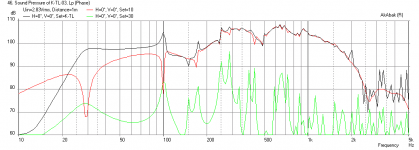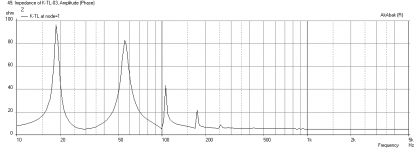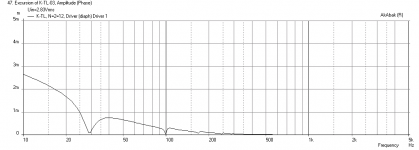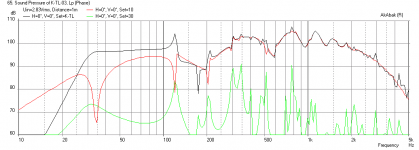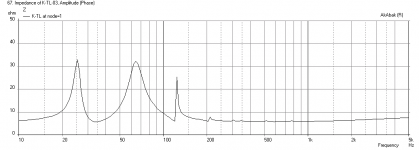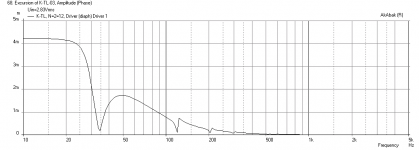1.5X Scale Karlsonator with a pro audio 15 inch coax
I ran a sim with a pro-style B&C 15HCX76 15 in coax PA driver (98dB Efficiency) for fun and scaled the K'nator simply by 18/12 with a vent scaling of 1.35X and it worked like a charm with a flat bass shelf around 98 dB at 1 w 1 m down to 30 Hz (before any falloff). I think this is a 13.5 cubic ft box though. If you want a smaller box, maybe a 10 or 12 in driver would be better?
I ran a sim with a pro-style B&C 15HCX76 15 in coax PA driver (98dB Efficiency) for fun and scaled the K'nator simply by 18/12 with a vent scaling of 1.35X and it worked like a charm with a flat bass shelf around 98 dB at 1 w 1 m down to 30 Hz (before any falloff). I think this is a 13.5 cubic ft box though. If you want a smaller box, maybe a 10 or 12 in driver would be better?
Attachments
Last edited:
There is a price for performance both from volume of the box and cash. In this case, the B&C coax will set you back $550 ea. My sims with the Betsy K 8 in yielded some very nice bass in a relatively small box. It almost went to 30 Hz and costs a lot less. But you won't get 98 dB.
did you mean "15/12" rather than "18/12" scaling? - I've two sets of Eminence 15cx but may prefer their 12cx. 1-604 - 2 Peavey 15cx but those have altered fs - that makes two sets of Peavey I have whose suspension seems to have significantly stiffened, raising fs and qes - love to find a new PV basket for their cx as they sounded very nice
IIRC, a BMS 15C362 is around $370 - its "heavy" in moving mass compared to classic coaxial
IIRC, a BMS 15C362 is around $370 - its "heavy" in moving mass compared to classic coaxial
An externally hosted image should be here but it was not working when we last tested it.
Last edited:
15:12 is 1.25x, so like it or not volume goes up 1.25^3, or about double. Depending on the specs, something in the 8 cu ft range might work OK, but of course you'll give up something.
Regarding a hypothetical Karlsonator 15 vs a K15, mostly you'd get more bass extension and hopefully a little smoother midbass FR.
Regarding a hypothetical Karlsonator 15 vs a K15, mostly you'd get more bass extension and hopefully a little smoother midbass FR.
there's plenty of modern 15s to work with a K-tube - - 15cx seem less plentiful - does the moving mass and low vas look unfavorable with this BMS? (it ought to be good for something) - the data is interesting on the HF "horn"
http://bmsspeakers.com/fileadmin/bm...ces/bms_15c362_2011-04_coaxial_transdcuer.pdf
the lowest mass recent 15 was the Peavey HE at 53g mms - I think the neo version has been discontinued -
here's the neo in a Karlson X15 http://img412.imageshack.us/img412/1390/x15pvr.jpg
10-12 cubic feet isn't bad - if its in a skinny form
http://bmsspeakers.com/fileadmin/bm...ces/bms_15c362_2011-04_coaxial_transdcuer.pdf
the lowest mass recent 15 was the Peavey HE at 53g mms - I think the neo version has been discontinued -
here's the neo in a Karlson X15 http://img412.imageshack.us/img412/1390/x15pvr.jpg
10-12 cubic feet isn't bad - if its in a skinny form
Last edited:
I don't think the Karlson was designed, in the sense that it was a piece of industrial design. AFAIK, the design originates Karlson himself, an engineer, and the form is rather secondary to the function. The dramatic slot was not an aesthetic flourish. The Paragon, on the other hand, was professionally designed in Berkeley, CA by Arnold Wolf, a well known industrial designer.
AFA distinctions between "soft googie", mid-century modern, "Danish modern", etc; these are contemporary categories and distinctions. All of these styles would have been considered "International Style" or simply "modern" at the time.
This is a classic mistake: To think that zeitgeist and fashion doesn't influence the shapes and concepts an engineer chooses. And to think that pure reason and rationality (whatever that is) solely dictates how a well engineered object looks like and works. Reality is, as per usual, much more intertwined and complicated.
I think If you presented a photo, or perhaps more fairly a line drawing of a Karlson cab to average people on the street and asked them to place it in time, a huge percentage would get it right from looks alone and virtually no one would say it was from today.
And about the terms "soft googie", mid-century modern, "Danish modern": The first and the last was actually used at the time.
Googie was a coffee shop in Hollywood from the late 40's, whose architectural style came to mark the change from the more bombastic, baroque art deco and streamline to the more playful, postmodern googie.
"Danish modern" or similar was also much used at the time for stuff made by guys such as Finn Juhl, Arne Jacobsen and Hans Wegner.
MCM was of course not used, as they didn't know how long it would last back then. I'd ad that we don't yet. It could be argued that we are still in that period.
To do what?I fail to see your point. The whole purpose of this design is to do just that. It's not like there's been thousands of people copying this obscure design over and over anyway.
Anyway, my point was that the karlson enclosure, as it is discussed in this thread, was at the outset not meant to be the ultimate manifestation of his ideas. It is a halfway house in a lot of ways.
IMO something like the clam is probably closer, or at least a cleaner design.
Last edited:
I agree with the last paragraph written by squeak. I don't think that the cabinets we are seeing, even Karlson's own, were what was covered in the original idea. they were more like a large quarter wave length tube with the slot coming down about 2/3 to 3/4 of the tube length. The klam is the closest in concept to the original idea. Somebody else posted photos in one of the Karlson threads of Karlsons that were made in larger tubes. Of course the small tube that Freddi is so enthusiastic about is true to the original concept also, just on a small scale.
jamikl
jamikl
Not sure why architectural styles are being discussed - these names and period terminology have nothing to do with the sound. The sound is really what it is all about with the Karlson. Having studied the actual shape and function of the K15 thoroughly as to be able to model it in AkAbak using a series of about 40 nodes, I can say that the form follows function. Karlson happened to develop it in 1940's and 1950's but if he did it today it would look very much the same.
If you look at the requirements and how a speaker is typically built given Karlson aperture (which really was not invented by Karlson but adapted from standard microwave transmission line and antenna theory), you will see that the K15 shapes is one of the solutions. The requirements include: compactness, easy to construct, high acoustical coupling efficiency between driver and air, large bass gain bandwidth, good directivity, and placement on the floor. Thus compactness requires folding the path, easy to construct requires rectilinear cuts and a box like final shape, high coupling efficiency makes the design a dual chamber reflex and tapped horn hybrid, wide bass gain uses the K aperture coupler on the exit, good directivity requires K aperture to be placed vertically oriented and on the front with the apex at the top so that HF disperses widely and bass utilizes floor loading to enhance gain. Floor placement requires the driver to be tilted up to improve directivity of HF and floor placement with large end of slot at bottom requires driver to be at lower end of box rather than on top of box. All these design features as you can see, follow function and engineering requirements not fancy form requirements.
Regarding why the design looks "dated" it perhaps was built with too much from the school of form follows function. Perhaps if some oblique angles and a slightly slanted cabinet were made vs rectangular prism like shape it would immediately change the architectural style period. However that would violate the requirement of easy to construct via rectilinear cuts. The only non rectilinear cut is the arc in the K aperture itself but that is the only one and is needed by a functional requirement - not architectural design or form requirement.
If you look at the requirements and how a speaker is typically built given Karlson aperture (which really was not invented by Karlson but adapted from standard microwave transmission line and antenna theory), you will see that the K15 shapes is one of the solutions. The requirements include: compactness, easy to construct, high acoustical coupling efficiency between driver and air, large bass gain bandwidth, good directivity, and placement on the floor. Thus compactness requires folding the path, easy to construct requires rectilinear cuts and a box like final shape, high coupling efficiency makes the design a dual chamber reflex and tapped horn hybrid, wide bass gain uses the K aperture coupler on the exit, good directivity requires K aperture to be placed vertically oriented and on the front with the apex at the top so that HF disperses widely and bass utilizes floor loading to enhance gain. Floor placement requires the driver to be tilted up to improve directivity of HF and floor placement with large end of slot at bottom requires driver to be at lower end of box rather than on top of box. All these design features as you can see, follow function and engineering requirements not fancy form requirements.
Regarding why the design looks "dated" it perhaps was built with too much from the school of form follows function. Perhaps if some oblique angles and a slightly slanted cabinet were made vs rectangular prism like shape it would immediately change the architectural style period. However that would violate the requirement of easy to construct via rectilinear cuts. The only non rectilinear cut is the arc in the K aperture itself but that is the only one and is needed by a functional requirement - not architectural design or form requirement.
Last edited:
Larry,
Betsy K works well in either K15 or Karlsonator depends on your needs. Do you plan to place it near a wall in a room? Then go with Karlsonator which will get to 30 Hz. If you plan to use in large space or outdoors where efficiency is most important, go with K15. K15 only goes to 60 Hz but packs a punch of 90 dB at 5 meters away on 1 watt.
Betsy K works well in either K15 or Karlsonator depends on your needs. Do you plan to place it near a wall in a room? Then go with Karlsonator which will get to 30 Hz. If you plan to use in large space or outdoors where efficiency is most important, go with K15. K15 only goes to 60 Hz but packs a punch of 90 dB at 5 meters away on 1 watt.
the original Karlson, finished by the summer of 1951 (recollection by Karlson vice-president Wayne Green) is surely form follows function resulting in a beautiful form.
Larry - BetsyK and Visaton's BG20 play pretty well in a stock K12.
I've run BetsyK in cabinets from K8 to K12 to a tall versi n of K8 which was once dubbed "XK8" - it was 13.5W x 28" high - I think the height could have been reduced. When compared to BetsyK in a Karlsonette (first K12 of late 1954), the skinny XK8 exhibited 2-5dB less output than the K12 in the 110->220Hz octave - so I think the skinny cabinet was closer to neutral and without as much "hit"
a modified aperture could be useful in some little K's - I don't know it impacts the overall response vs the typical radial arc.
I've misplaced my camera - was going to show a K8-K9 size coupler built just like K15 - it is punchy and used as size for the SK8 project
BetsyK in a factory 1960's K8 - nice vocals - no punch - needs a sub
BetsyK in a factory 1954-55 K12 - very impressive bass - add a helper tweeter
BetsyK in the tall XK8
BetsyK response - I think the tilt-down is party from its position in my room as
my Advent measured similar in 100-500Hz
BetsyK sounds very nice in Art Welter's dad's K8 based on K12 - despite the large slots, this tunes in the same ~100Hz region as Karlson's K8 with 2-3 smaller slots/slits
SK8 with modified aperture
SK8 next to factory K8
Larry - BetsyK and Visaton's BG20 play pretty well in a stock K12.
I've run BetsyK in cabinets from K8 to K12 to a tall versi n of K8 which was once dubbed "XK8" - it was 13.5W x 28" high - I think the height could have been reduced. When compared to BetsyK in a Karlsonette (first K12 of late 1954), the skinny XK8 exhibited 2-5dB less output than the K12 in the 110->220Hz octave - so I think the skinny cabinet was closer to neutral and without as much "hit"
a modified aperture could be useful in some little K's - I don't know it impacts the overall response vs the typical radial arc.
I've misplaced my camera - was going to show a K8-K9 size coupler built just like K15 - it is punchy and used as size for the SK8 project
BetsyK in a factory 1960's K8 - nice vocals - no punch - needs a sub
An externally hosted image should be here but it was not working when we last tested it.
BetsyK in a factory 1954-55 K12 - very impressive bass - add a helper tweeter
An externally hosted image should be here but it was not working when we last tested it.
BetsyK in the tall XK8
An externally hosted image should be here but it was not working when we last tested it.
BetsyK response - I think the tilt-down is party from its position in my room as
my Advent measured similar in 100-500Hz
An externally hosted image should be here but it was not working when we last tested it.
BetsyK sounds very nice in Art Welter's dad's K8 based on K12 - despite the large slots, this tunes in the same ~100Hz region as Karlson's K8 with 2-3 smaller slots/slits
An externally hosted image should be here but it was not working when we last tested it.
SK8 with modified aperture
An externally hosted image should be here but it was not working when we last tested it.
SK8 next to factory K8
An externally hosted image should be here but it was not working when we last tested it.
Last edited:
hey XRK971 - what effects good and bad would you expect from using the following aperture for K's with the same frontal aspect as the "SK8" below? - it might work with some little K - the little SK8 below sounded pretty good with even tighter aperture than radial arc when loaded with FE206EN - 206EN has strong "hit" in a K12
SK8 with modified aperture
SK8 with modified aperture
An externally hosted image should be here but it was not working when we last tested it.
Last edited:
Betsy K in 1.25X Scale Karlsonator
Larry,
Here is the sim of the Betsy K in a 1.25X scale Karlsonator with the vent scaled up by additional 1.2X. You can get some pretty impressive bass down to 30 Hz from a cabinet that is about 37 in tall.
Can anyone suggest which Karlsonator cabinet would best suit Betsy K's? Looks like a compact solution vs MLTL cabs.
Thanks
Larry
Larry,
Here is the sim of the Betsy K in a 1.25X scale Karlsonator with the vent scaled up by additional 1.2X. You can get some pretty impressive bass down to 30 Hz from a cabinet that is about 37 in tall.
Attachments
that's really low bass from BetsyK! X - do you think there's any point to making a sub-only Karksonator with perhaps a 12" which can move some air vs other enclosures? my TSG coax for "fullrange" has a healthy 4.6mm one way excursion and 4" coil for regular duty. Perhaps the best value for a wide range Karlsonator would be Eminence's Beta 10cx with ASD1001 compression driver.
Last edited:
- Home
- Loudspeakers
- Full Range
- Karlsonator
